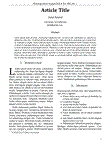Resultados de búsqueda - ((esta OR protein) OR (esto OR ((ttest OR (esteea OR estos)) OR (estoe OR resto)))) point*
Materias dentro de su búsqueda.
Materias dentro de su búsqueda.
- México 4
- Educación 3
- Education 3
- Facebook 3
- I21 3
- 2
- Administración 2
- Alimentación 2
- Calidad 2
- Conocimiento 2
- Democracia 2
- Democracy 2
- Desarrollo urbano 2
- Educación Superior 2
- Human Capital 2
- Innovación 2
- Innovation 2
- Knowledge 2
- Mediación 2
- Mexico 2
- O47 2
- Quality 2
- Sociedad 2
- Society 2
- Violence 2
- calidad 2
- comunicación política 2
- control 2
- democracia 2
- democracy 2
-
1
Increased cerebrospinal fluid levels of cytokines monocyte chemoattractant protein-1 (MCP-1) and macrophage inflammatory protein-1β (MIP-1β) in patients with amyotrophic lateral sc...
Publicado 2020“…Cytokine levels were analysed in relation to ALS duration (< 12 months vs > 12 months) and severity (< 30 points vs > 30 points on the ALS Functional Rating Scale administered at hospital admission). …”
Enlace del recurso
Artículo -
2
Contribution to Protein/Energy Requirement and Metabolic Aspects for Two Carnivorous Species Lates Calcarifer, Epinephelus Morio Juveniles with Reference to Trout
Publicado 2011“…Relative requirement was assess however the absolute requirement in terms of g protein per 100g biomass per day was 1.5g protein for 50kJ DE to reach a specific growth rate of 2.4%more useful from a practical point of view. …”
Enlace del recurso
Artículo -
3
Puntos de vista de la responsabilidad social corporativa (Points of view on social corporate responsibility
Publicado 2005“…This study has the objective ofpresenting the differents points of view about Corporate Social Responsibility (CSR) in the business world. …”
Enlace del recurso
Artículo -
4
-
5
-
6
-
7
-
8
-
9
Raw Ingredients for Marine Aquaculture Fish
Publicado 2019“…Outlines of thepaper were set to sum up 5 years research on sea bass culture (Aquacop, 1989-94) and drawa comparative approach (sea bass, snook, red drum) from an ADC point of view,optimum P/E at different stage of development : larvae, weaning, fingerlings at nursery,juveniles and grow-out making emphasis on animal vs plant protein : soybean meal withnutritional aspects and appetibility, fishmeal and fish oil criteria to end up with breedersrequirement and feeding.…”
Enlace del recurso
Artículo -
10
-
11
Quién es quién en el consumo mundial de acero: impactos y tendencias globales
Publicado 2012Enlace del recurso
Artículo -
12
Who's who in the steel consumption in the world: global trends and impact (Quién es quién en el consumo mundial de acero: impactos y tendencias globales)
Publicado 2012“…It is important to determine the main differences and identify the key points of improvement; this may help improve the strategy for getting better numbers in order to improve and maintain constant growth of a country and ensure a sustainable development. …”
Enlace del recurso
Artículo -
13
The Effects of Animal or Plant-Based Diets on Energy Partitioning in Selected Ontogenetic Stages of the Shrimp Litopenaeus vannamei
Publicado 2019“…L.vannamei is apromising species from this point of view to examine ontogenetic variations of its performance whetherreceiving animal or plant-based diets. …”
Enlace del recurso
Artículo -
14
-
15
-
16
Evaluación de un protocolo de entrenamiento canino utilizando una línea celular b16f10 para la detección de melanoma en un modelo murino
Publicado 2020“…Therefore we assume that the cell line and the biological samples emit common volatile signals that allow the dog to discriminate them, however, the results of the first tests indicate that the spontaneous change of the matrix in which they are found causes doubt and hesitation when pointing out the samples of mice with cancer. Even so, we do not recommend as in the in vivo model a radical and sudden change of objective samples for the identification of murine melanoma with dogs trained with the cell line.…”
Enlace del recurso
Tesis -
17
Evaluación de un protocolo de entrenamiento canino utilizando una línea celular b16f10 para la detección de melanoma en un modelo murino
Publicado 2020“…Therefore we assume that the cell line and the biological samples emit common volatile signals that allow the dog to discriminate them, however, the results of the first tests indicate that the spontaneous change of the matrix in which they are found causes doubt and hesitation when pointing out the samples of mice with cancer. Even so, we do not recommend as in the in vivo model a radical and sudden change of objective samples for the identification of murine melanoma with dogs trained with the cell line.…”
Enlace del recurso
Tesis -
18
Suppression of cell migration is promoted by miR-944 through targeting of SIAH1 and PTP4A1 in breast cancer cells
Publicado 2016“…Conclusions: Our results pointed out that miR-944 is a novel upstream negative regulator of SIAH1 and PTP4A1 genes and provided for the first time evidence for its functional role in migration and invasion of breast cancer cells. …”
Enlace del recurso
Artículo -
19
-
20
Mutación en el gen EDA1, Ala349Thr en paciente con displasia ectodérmica hipohidrótica ligada a X
Publicado 2011“…It is caused by mutations within the ED1 gene, which encodes a protein, ectodysplasin-A (EDA). Clinical characteristic are frontal bossing, saddle nose, pointed chin, a prominent supraorbital ridge with periorbital hyperpigmentation, and anodontia. …”
Enlace del recurso
Artículo


